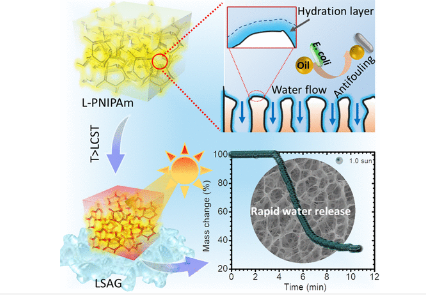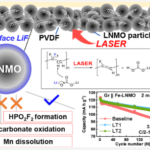2023-02-08 プリンストン大学
◆このデバイスは、2021年に開発された第一世代の技術に比べて、約4倍のろ過率を実証しています。厚さ1cmの素材1平方メートルで、わずか10分で1ガロン以上の水を作ることができ、世界の多くの地域で日々の需要を満たすのに十分な量のきれいな水を提供できる可能性があります。この新しい太陽熱吸収ゲルの詳細は、2月8日付のACS Central Scienceに掲載されました。
◆この装置のスポンジのような外観の核となるのは、ポリ(N-イソプロピルアクリルアミド)またはPNIPAmとして知られるポリマーで形成されたゲルです。これは、温度に応じて、水を吸収したり放出したりすることができます。
◆このハイドロゲルは、摂氏33度(華氏91度)以下ではスポンジのように湖などの水源から水を吸収する。しかし、ハイドロゲルを水から取り出し、太陽光で33度以上に加熱すると、水を放出し始める。ゲルの表面にポリドーパミン(PDA)などのポリマーを加えることで、この装置は、油、重金属、マイクロプラスチック、ある種のバクテリアなどの汚染物質を水からろ過することができる。
◆研究者によると、このゲルは、蒸発に依存する既存のシステムよりも安価でシンプルに使用できるという。ユーザーは、スポンジ状の装置を飽和状態になるまで水源に放り込むだけでよい。そして、水から取り出し、日光の下に置いて、ろ過された水が出るのを待つ。真昼の太陽の下では、わずか10分ほどで吸収した水の約70%を放出することができるそうです。
◆Xuによれば、ろ過速度の劇的な向上は、第1世代と第2世代の間でハイドロゲルの構造に変更を加え、水を輸送する能力を強化したことに起因するという。第1世代も第2世代も同じPNIPAmハイドロゲルを使用しているが、水とエチレングリコールの混合液でポリマーを合成することにより、ゲルをより相互に結合した繊維状の構造に変えることができることを発見したのである。
◆この従来にないアプローチは、水の輸送を妨げる壁があるハニカム状の構造をとりがちな既存のハイドロゲルを大きく改善することにつながったと、Xu准教授は語っている。この新しいハイドロゲルの繊維状構造は、浴室や台所でたわしのように使われるヘチマの成熟した実によく似ていると、徐教授は述べている。
<関連情報>
- https://engineering.princeton.edu/news/2023/02/08/solar-powered-gel-filters-enough-clean-water-meet-daily-needs
- https://pubs.acs.org/doi/10.1021/acscentsci.2c01245
太陽光発電による水質浄化のための速放性防汚ハイドロゲル Quick-Release Antifouling Hydrogels for Solar-Driven Water Purification
Xiaohui Xu, Néhémie Guillomaitre, Kofi S. S. Christie, R. Ko̅nane Bay, Navid Bizmark, Sujit S. Datta, Zhiyong Jason Ren and Rodney D. Priestley
ACS Central Science Published:February 8, 2023
DOI:https://doi.org/10.1021/acscentsci.2c01245

Abstract
Hydrogels are promising soft materials for energy and environmental applications, including sustainable and off-grid water purification and harvesting. A current impediment to technology translation is the low water production rate well below daily human demand. To overcome this challenge, we designed a rapid-response, antifouling, loofah-inspired solar absorber gel (LSAG) capable of producing potable water from various contaminated sources at a rate of ∼26 kg m–2 h–1, which is sufficient to meet daily water demand. The LSAG─produced at room temperature via aqueous processing using an ethylene glycol (EG)–water mixture─uniquely integrates the attributes of poly(N-isopropylacrylamide) (PNIPAm), polydopamine (PDA), and poly(sulfobetaine methacrylate) (PSBMA) to enable off-grid water purification with enhanced photothermal response and the capacity to prevent oil fouling and biofouling. The use of the EG–water mixture was critical to forming the loofah-like structure with enhanced water transport. Remarkably, under sunlight irradiations of 1 and 0.5 sun, the LSAG required only 10 and 20 min to release ∼70% of its stored liquid water, respectively. Equally important, we demonstrate the ability of LSAG to purify water from various harmful sources, including those containing small molecules, oils, metals, and microplastics.



